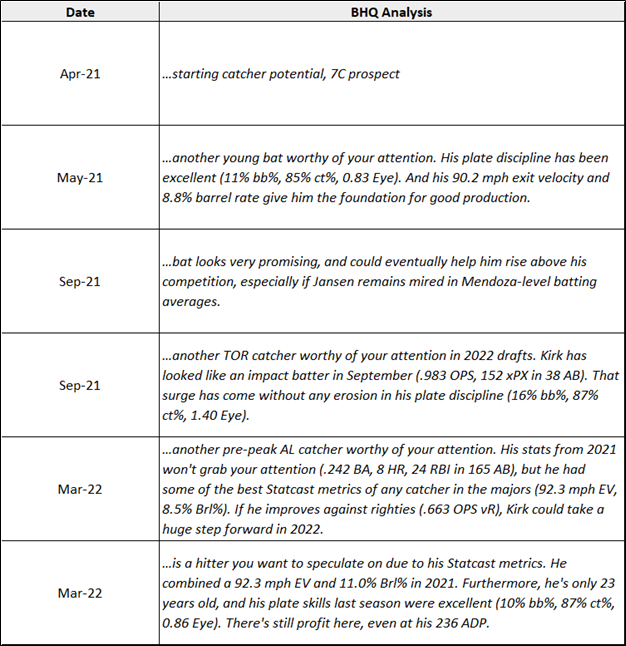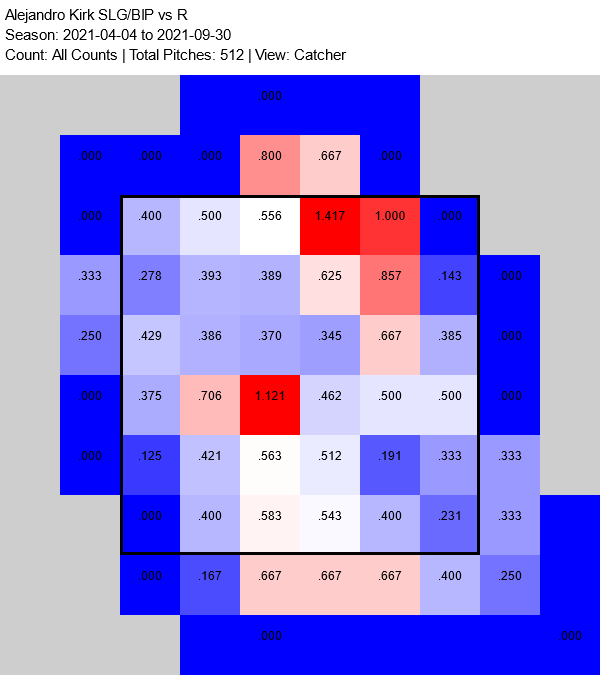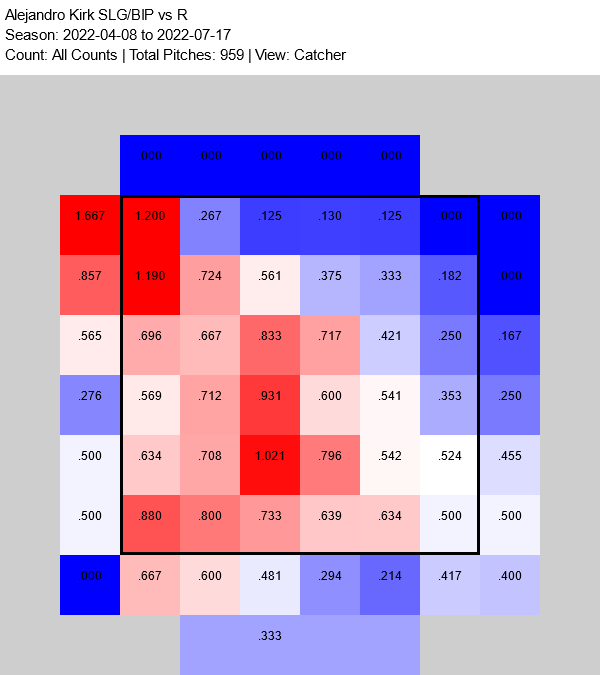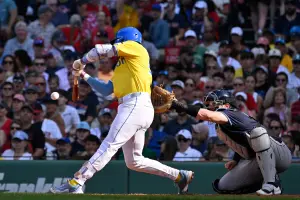
(*) F/F SPOTLIGHT: Alejandro Kirk
Typically, we shine our F/F Spotlight only on players with at least two full seasons' worth of stats so that we have large sample sizes from which to analyze trends and draw conclusions.
The emergence of Alejandro Kirk (C/DH, TOR) this season has enticed us to alter that approach, at least for this week.
He’s on his way to a $20 return in his first full MLB season:
His solid debut in 2021 fueled the market to view him as a player with good second-catcher appeal on draft day (220 ADP). Our subscribers were alerted to Kirk’s potential to be more than that heading into 2022 drafts:
Let’s dig deeper to find out if we should view Kirk’s first half as a flash in the pan or a point on his growth curve.
In the hunt? BaseballHQ.com can help you snag the title. Unlock all of our insights like these for the rest of the season: Subscribe to BaseballHQ.com.
Batted Ball Quality
Kirk’s batted ball quality in 2021 drove his intrigue heading into this season, which confirms the value of targeting hitters with good batted ball characteristics underneath their surface stats (min 50 PA):
While Kirk’s batted ball quality has eroded slightly in 2022, his MLB percentile rankings for average exit velocity and xwOBA are firmly among the game’s elite:
His ability to hit the ball hard and barrel it gives good support to the impactful power and production that he is delivering.
That said, he could tap out as a 20-HR bat if his launch angle deterioration continues:
Fortunately this does not look like a chronic concern, as he was a line drive + fly ball hitter in June (62% LD% + FB%) before struggling to loft the ball in July (39% LD% + FB%).
Lefty/Righty Splits
Turns out that all of Kirk’s production in 2021 came against lefties (.314 BA, .988 OPS vL). He struggled to do much of anything against RHers (.211 BA, .663 OPS vR).
The reason to believe that he could close down this split could be found in his plate skills, which were excellent against both lefties and righties:
More on his plate skills in a bit, which actually have improved in 2022 from these already elite levels.
The maturity Kirk showed at the plate in 2021 has allowed him to reduce his LH/RH splits so far in 2022:
Kirk's slugging percentage heat map on balls in play from 2021 shows us that his power was inconsistent at best in the middle-in portion of the strike zone (FanGraphs.com):
Check out the level of red that has developed in those same quadrants in 2022 (FanGraphs.com):
Plate Discipline
As mentioned, Kirk has added two points to his already elite contact rate from 2021 (87%) to 2022 (89%).
Only 32 batters in the majors own an 85%+ ct% so far in 2022. On average, they have produced the following (min 50 PA):
.268 BA, 4 HR, 24 RBI, .701 OPS
Kirk’s combination of plate maturity and batted ball quality stands out even more among this group, which has an average 87.4 mph EV and 3.5% Brl% compared to Kirk’s own 91.5 mph EV and 9.2% Brl%.
In addition, analyzing a hitter’s swing profile can help to validate his rate of contact. Here are the percentage of times a typical hitter swings based on where the pitch is located (FanGraphs.com):
The swing profile of Kirk also features a high rate of swings inside the strike zone, but he differentiates himself by swinging at nearly zero very-inside and very-outside pitches (FanGraphs.com):
Likewise, we can use Statcast’s Swing Take tool as a means to quantify the number of runs a batter adds based on his swing/take profile (click on image to enlarge it):
This illustration tells us that Kirk adds five runs by swinging at pitches in the heart of the strike zone. It also suggests that increasing his swing rate on those meaty pitches could help him become even more productive.
His excellent batting eye allows him to take nearly all pitches that are well away from the strike zone (chase + waste). That skill allows Kirk to add 20 runs by taking 331 of the 378 pitches he sees in those areas.
Conclusions
At 5’8”, 265 lbs, Kirk’s plate approach and production play well above his physical appearance. His combination of elite plate discipline and upper-tier batted ball metrics give him the tools to be an impact bat. While his MLB sample size remains small, his plate discipline consistently is elite, which gives him a very high batting average floor.
His power and production are backed by his rates of exit velocity and barrels. Whether he settles as a 20-HR bat or one with 30-HR potential will be dependent upon his durability. He has battled hip and arm issues already in his brief MLB career, which could make him prone to late-season swoons, especially if he continues to get most of his starts behind the plate instead of at DH. We'll know more about his full-season upside once he finishes his first full MLB campaign.
Even with those risks, Kirk is heading toward a legit $20 season, and his maturity and thump will make him a low-risk frontline catcher going forward.















